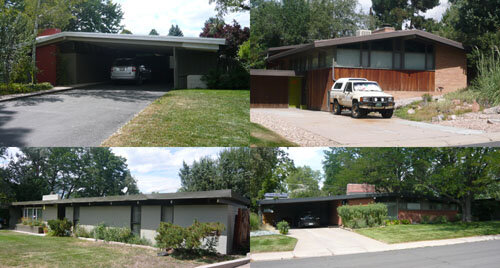It is rare that really good mid-century modern architecture finds itself not confined to the design of an isolated building. So much of the ethos of that period of Modernism was committed to making unique, site- and client-specific buildings, that it is unusual to see a cluster of homes that all reflect the design ambitions of Modernism. Arapahoe Acres in Englewood, Colorado is one of the shining exceptions.
Arapahoe Acres is a small, planned residential development bounded by more conventional developments and houses in suburban Englewood, just south of Denver. There are 124 houses, ranging from 850 to 2,500 square feet and all with flat or slightly pitched roofs and clearly unmistakable Modernist intentions. These are not all unique designs for individual clients, but rather a series of types, with significant variations, laid out on a curvilinear street pattern with knot-like semi cul-de-sacs. Most of the homes were designed between 1949 and 1957 by the developer and self-taught architect Edward Hawkins.
Arapahoe Acres recently held their annual home tour featuring the interior and exteriors of about 8 homes. What is most striking is that these relatively little houses were so thoughtfully planned and finished that few significant additions or harmful renovations have been executed. As the neighborhood is on the National Register as a Historic District, this would limit maybe the worst abuses, but I think the reason for the lack of alterations is more due to the open planning, careful spatial layering and utility that pervades these houses. So while many of them are quite small, the extensive use of natural materials, including some really nice masonry, and clear and simple expressive structural framing lends a quietude and richness that has argued well for many decades for retaining them as originally designed.
If you have a chance, take a drive around the neighborhood and you will see how really interesting it is. It is certainly suburban and houses all the difficulties that also plague most post-war car-centered developments. But the theme and variation, simple massing and consistent aesthetic makes for a very pleasing little oasis within the larger undifferentiated suburban sprawl of south Denver. And of course it is worth noting that this forward-looking development of well-designed and built homes, though now "historic", is still light-years ahead of most current developments with cheesy fake-Victorian model homes, wood composite siding and faux stone chateaus. Arapahoe Acres embodies the positive, can-do attitude of post-war America where the future was eagerly anticipated and the best was yet to come.
(Much of the history of Arapahoe Acres info above was gathered from the AA tour guide as assembled by Diane Wray Tomasso, resident and neighborhood historian)




